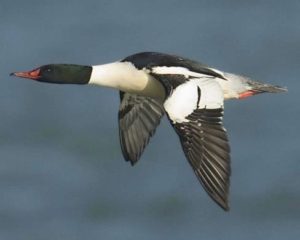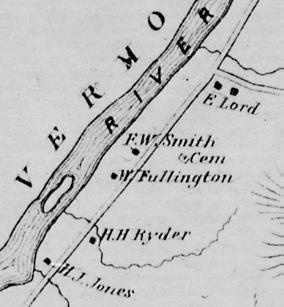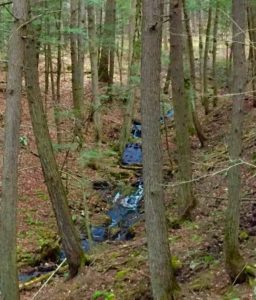Hike Direction and Map – Full PDF
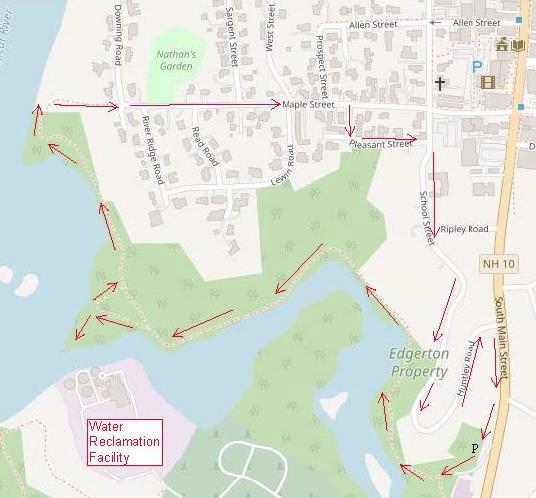 Driving Directions
Driving Directions
- From Downtown Hanover, drive S on S. Main St. for 0.3 miles
- Parking area is on R just before electric substation and bridge over Mink Brook.
What You Should Know
- Start your hike AFTER 11AM if you’d like to do the loop and visit the garden. Bring binoculars and a bird book!
- Today’s hike takes you along lower Mink Brook on a flat, ADA accessible path with benches. You can retrace your steps OR
- For a more challenging hike, continue on the banks of the CT River on a narrow, sometimes steep path and climb to the neighborhood tucked behind downtown. Return on quiet streets, visiting a small meditation garden that glows in fall.
- Dogs are welcome if under your control. Please pick up after your pet.
- Foot travel only.
Brief Hiking Directions
- Take the gravel path down through the gate and bear R along Mink Brook.
- The gravel path ends across from the Water Reclamation Facility. Turn around here OR
- Stay straight on a woods path; turn R at river’s edge
- Follow path along river to wood steps
- Climb wood steps to gate at Maple St./Downing St.
- Walk down Maple St.; turn R on Pleasant St. and R on School St.
- Follow School St. to sharp curve; visit Li Graben Meditation Garden
- Continue on School St. (becomes Huntley Ave.)
- Turn R onto S. Main St. and return to your car.
The Full Story
- Walk toward the electric station, bearing R before its parking lot, and go through the gate (better ADA access is from this lower lot). Bear R onto the packed gravel path along the water. You’ll notice that the trees are alive with birds at this season, stocking up on seeds and berries before launching themselves into the great migratory stream of wings that flows south along the Connecticut River flyway in fall.
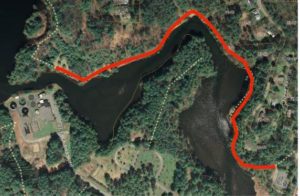 The Town of Hanover undertook an ambitious project in the summer/fall of 2019 to create a 3,700 foot fully ADA compliant, accessible path along this beautiful stream (marked in red on aerial photo). Benches beckon visitors to stop and enjoy the views, reflections, and especially the waterfowl that frequent this area.
The Town of Hanover undertook an ambitious project in the summer/fall of 2019 to create a 3,700 foot fully ADA compliant, accessible path along this beautiful stream (marked in red on aerial photo). Benches beckon visitors to stop and enjoy the views, reflections, and especially the waterfowl that frequent this area.- Note the blue and white tags identifying this as Town Conservation land. Working with the Town, the Hanover Conservancy (then the Hanover Conservation Council) contributed half the purchase price for the 15.7 acre former Edgerton property on Mink
- Brook and the river in 1973. With protection of the Conservancy’s Mink Brook Nature Preserve just upstream in 1999, nearly 2 miles of the stream are now protected and open to the public.
- Fall is the perfect time to enjoy the foliage and feathered things here. The flame of maples may be winding down, but the oaks are golden bronze and we can (if grudgingly) enjoy the brilliant foliage of burning bush, an invasive garden escape. Note the sewer covers along the path – you and the wastewater piped under your feet are both traveling in the same direction – toward renewal! Thankfully, the Water Reclamation Facility (once known as a wastewater treatment plant) to which it is headed has restored Mink Brook and the Connecticut River from the ugly open sewers of the 1960s back to the beautiful waterways they are today.
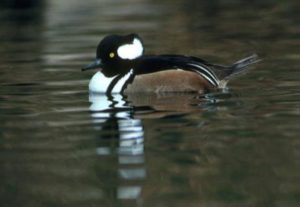 Lower Mink Brook, so close to the Connecticut River flyway, is known for its waterfowl. On the day we scouted this route (Oct. 30), two male hooded mergansers (R ) were bobbing their bright white mops of head feathers and croaking in attempts to impress the less gaudy females with them. Further downstream, a dozen Canada geese rested on a fallen log (below). Occasional broad stone slabs and more formal benches invite you to stop to watch.
Lower Mink Brook, so close to the Connecticut River flyway, is known for its waterfowl. On the day we scouted this route (Oct. 30), two male hooded mergansers (R ) were bobbing their bright white mops of head feathers and croaking in attempts to impress the less gaudy females with them. Further downstream, a dozen Canada geese rested on a fallen log (below). Occasional broad stone slabs and more formal benches invite you to stop to watch.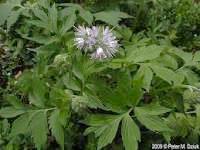
- At the first bend you’ll see pink flagging marking a patch of Virginia waterleaf (L), a plant of moist woods and floodplains, considered threatened in NH. It is protected here.
- As you proceed, note the steep slopes at R, decorated with evergreen Christmas fern.
- Like similar slopes at the Rinker-Steele Natural Area and Kendal Riverfront Park, these are remnants of Lake Hitchcock, which flooded this area as the glacier receded.
- The brook bends, its original channel filled with river water backed up behind Wilder Dam just a short distance downstream on the Connecticut. Before the dam was built in 1950, this would have been a narrow but obviously flowing stream, probably small and shallow enough to wade through at this time of year.
- Soon the Water Reclamation Facility comes into view. 20 minutes’ walk from your car, and opposite the plant, the ADA path ends. Here you can choose to turn around and see what new birds might have alighted in your wake, or continue on.

- To continue, proceed straight ahead on an un-blazed woods path across a wet area and up a knob. At the top, turn L for a short way to where the path ends at the mouth of Mink Brook. Take care on the hemlock-clad point – the clay soils are slippery when wet. The brook may be narrow here, but it is the largest in Hanover, draining an 18 sq.mi. watershed from the ridge of Moose Mtn. through Etna and along Greensboro Road.
- Return to the intersection and stay straight down a short hill, following the river for <15 minutes to another viewpoint. The path narrows as it passes another inlet. Stay L along the water as several paths join at R. The trail is narrow and benched, and passes a small island that was part of the shore before Wilder Dam flooded the area. Sinewy stems of ironwood or musclewood trees lean toward the water. Across the river a short section of railroad bed is visible, but beyond the sounds of I-91 and yard work in the neighborhood above, you might as well be 100 miles from civilization.
- The trail, unmarked but easy to follow, skirts another backwater and rises to another point of land. Watch for bald eagles – on our scouting day, an immature and an adult were perching overhead. Eagles have made a substantial comeback in the last 10 years, with dozens of nests along the Connecticut where there was only one in 1995. Some overwinter in this area, where they fish in the open water around Wilder Dam.
- The view S from the point includes the pine and hemlock-clad South Esker, another natural area purchased by the Conservancy and Town in 1971. See our Hikes of the Month to visit those trails. Across the river appear benches and trails at the Montshire Museum in VT.
- The trail passes over a steep-sided ridge with water on both sides. A few minutes later, take the R fork through a cut in a large log and head up a set of wooden steps. The trail swings R, edged with sections of cut log, and then curves up more steeply among the homes on the ridge above. Wood steps are your guide.
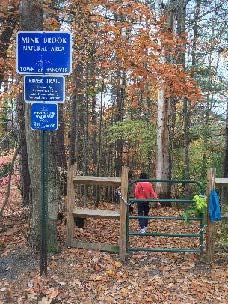
- 7 minutes’ hike up from the eagles’ point, arrive at the top of the ridge and a gate (walk around) at the junction of Maple and Downing Streets. A handsome new kiosk displays a useful map and signs remind that the trail is open from dawn to dusk only. Parking for this part of the trail is at the other end of Maple Street.
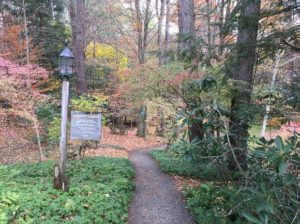 Start down Maple St.; opposite the junction with River Ridge Rd,, look for the entrance to Nathan’s Garden at L. This beautiful secluded natural area (R ) is open to the public (dawn to dusk) through the kindness of the landowner. Make a note to come back in spring and summer.
Start down Maple St.; opposite the junction with River Ridge Rd,, look for the entrance to Nathan’s Garden at L. This beautiful secluded natural area (R ) is open to the public (dawn to dusk) through the kindness of the landowner. Make a note to come back in spring and summer.- Continue on Maple St. Can you spot the bear family on a weathervane? For all the civilized look of this neighborhood, it’s prime bear territory, or at least it was until the neighbors took in their birdfeeders and covered up their compost piles, and the bears went elsewhere.
- This part of the hike (<½ hour) makes you wish you’d brought a field guide to historic architecture along with your bird guide. Turrets, porches, eave decorations, fanciful shingles, and even stained glass panels evoke the 1860s-1920s when this neighborhood grew up. It’s a pleasant mix of Italianate, Second Empire, Stick, Queen Anne, Shingle, and Colonial Revival styles. Bright-leaved barberry and burning bush decorate front yards, more appropriate habitat than streambanks.
- Turn R on Pleasant St. and enjoy the view out over the Mink Brook valley as it curves to the L.
- Turn R on School St. If you are pressed for time, turn L on Ripley and R onto S. Main St. to return to your car.
- You’ll be glad you continued on School St., passing the pretty forested section at L, and over the brook at R.
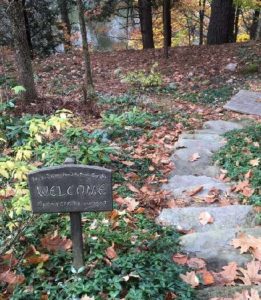
- Just before the street curves L, watch for a small sign at R welcoming you to the Li Graben Meditation Garden, open noon to sunset. Follow the short stone path and turn R onto a wooden deck path that leads to a tiny covered seating area. Here, you can contemplate the brook below and a peaceful scene created by stones arranged in a gravel bed. Azaleas will be bouncing with color in spring, but at this time of year, you’re treated to the brilliant yellow feathery blossoms of
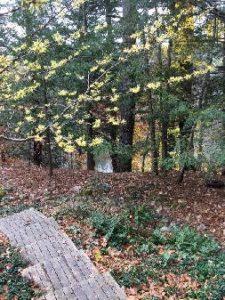 witchhazel (L)! Sit for a bit to enjoy the silent company of a public-spirited landowner who provides this space. In the shelter, discover a journal of poems left by visitors, including one who declared, “the river is Byootyefl!”
witchhazel (L)! Sit for a bit to enjoy the silent company of a public-spirited landowner who provides this space. In the shelter, discover a journal of poems left by visitors, including one who declared, “the river is Byootyefl!” - Return to School St. and follow it down as it becomes Huntley Rd., marveling at this neighborhood arranged on the challenging terrain left by glacial Lake Hitchcock.
- Turn R onto S. Main Street. Your car is close, but the fun is not over. Just as the small parking area comes into view, note the Greek Revival style brick cape that sits across the road on your L. This house was built in 1840 by Ruben Benton, a Hanover selectman at the time, when his earlier home burned. In 1852, Ruben’s son Charles added a massive barn (131’ x 45’, four stories high) that was a landmark in town for a century. In 1885, the Benton Farm included 150 acres of land in Hanover and 174 in abutting Lebanon, 140 Merino sheep, and a sawmill. That land included the brook side area you’ve just explored plus the Mink Brook Nature Preserve and much more.
-
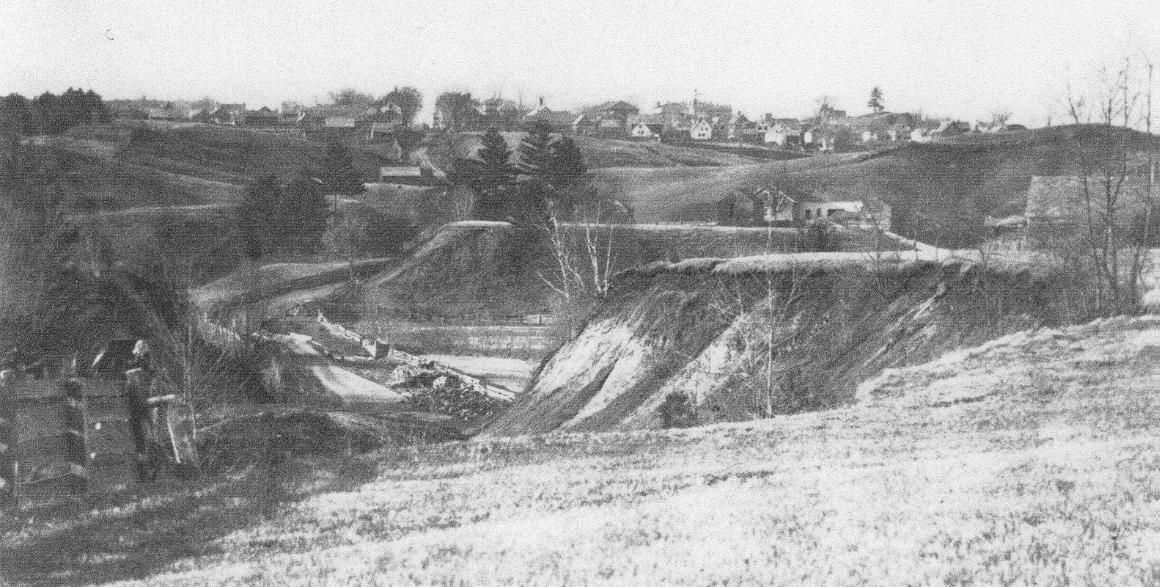
The Benton Farm – view N to Hanover village across Mink Brook c. 1865 - After Charles Benton’s death, his family sold the farm to Dartmouth College for $4,500. Five years later in 1903, the college traded this farm for Charles Stone’s farm on the Wolfeboro Road in the future Trescott Water Supply lands to make room for the new Fletcher Reservoir. Stone milked his dairy herd at the Trescott lands in the morning, herded them down Reservoir and Lyme Roads into town and down Main Street, and milked them in their new barn that evening.
- The Stones later sold off pieces of their farm to the electric company (1928), to the town to re-route S. Main Street, to the hydro power company to allow Wilder Dam to flood the lower brook, and for residential development on parts of Buell St., Mourlyn, and S. Main, among other things. Finally, in 1949, the Stones sold the remaining 169 acres to three families who developed the residential area around Brook Road, and the landmark barn came down.
- Time to return to your car at R.
This Hanover Hike of the Month has been generously sponsored by
November 2019





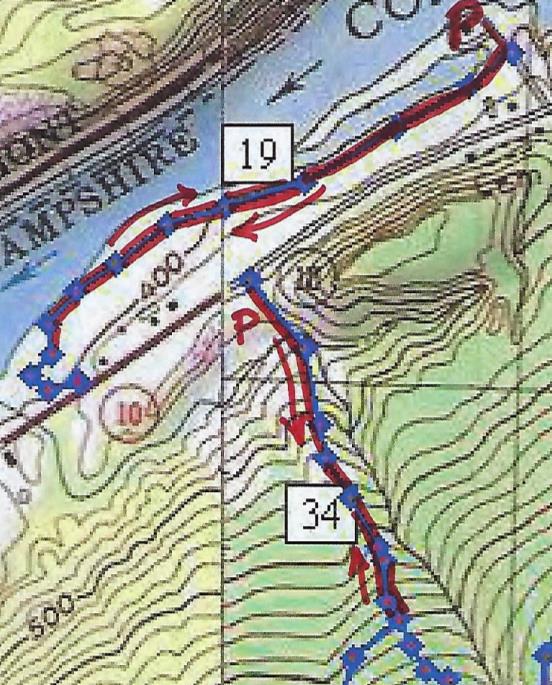 Driving Directions
Driving Directions